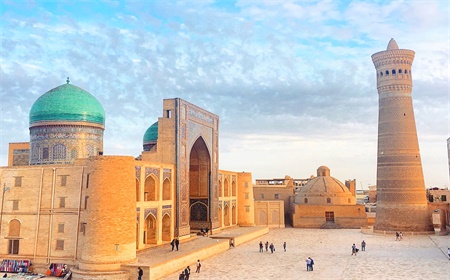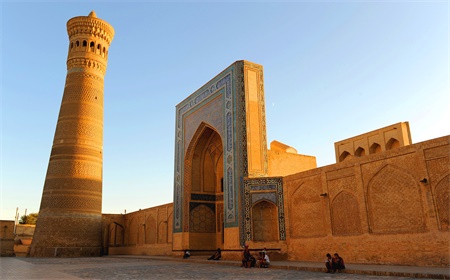Sacred Bukhara is one of the most esteemed cities in Islamic civilization. It is situated in the centre of the ancient agricultural oasis in the lower reaches of the Zarafshan River(3946N, 6425'E). Bukhara gained the status of a sacred town in pre-Arabian times. It was probably an ancient temple area, dating back to the 2nd millennium B. C. The name of the city is related to the Sanskrit "vihara" "shrine, monastery." The same idea is rendered by medieval sources that report that the Zoroastrian Magi and idolaters translated the name "Bukhara" as a "temple." "Bukhara", as well as "vihara", can be derived from the Sanskrit "Varahi" the land of boar (Varaha)", which means "holy land", as the boar was revered as a symbol of the priesthood.
 Referring to the holiness of the land of Bukhara there was a saying: " If anywhere in the world the light comes from above, in Bukhara, it streams out of the earth." As one of the strategic position on the Silk Road, the city has long been a centre of trade, scholarship, culture, and religion. During the golden age of the Samanids, Bukhara became a major intellectual centre of the Islamic world, second only to Baghdad. The historic centre of Bukhara, which contains numerous mosques and madrassas, has been listed by UNESCO as a World Heritage Site.
Referring to the holiness of the land of Bukhara there was a saying: " If anywhere in the world the light comes from above, in Bukhara, it streams out of the earth." As one of the strategic position on the Silk Road, the city has long been a centre of trade, scholarship, culture, and religion. During the golden age of the Samanids, Bukhara became a major intellectual centre of the Islamic world, second only to Baghdad. The historic centre of Bukhara, which contains numerous mosques and madrassas, has been listed by UNESCO as a World Heritage Site.
Ancient Bukhara:
The earliest layers of the urban culture of Bukhara have an age of 2500 years. Its most ancient monuments are the well of Job-Chash-ma-Ayub, associated with the name of the prophet Job(Ayub), and citadel Ark, which had a major Zoroastrian temple. Local rulers struck their own coins from the 2nd century B.C. In the 3rd - 4th centuries after a great drought, Bukhara's oasis went through a period of decline. A recovery began in the middle of the 5th century and was associated with the reviving of trade on the Silk Road. 
The Hephthalites ( 5th to 7th Centuries ) and then the Turks (6 to 7th Centuries ) who conquered Bukhara land patronized the trade and collect taxes. In the 7th Century, the Bukhara Union of the Princedoms was headed by rulers with the title of Bukhar-Hudat. In the early eighth century, the Arabian commander Quteiban conquered Bukhara and constructed the first mosque in the city. At the end of the 9th century, Bukhara became the capital of the Samanid Power. In the 9th - 11th Centuries the city was protected with new high walls. The title Po-i Kalan belongs to the architectural complex located at the base of the great minaret Kalan.



































